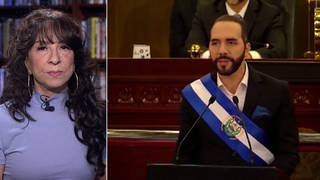
Rajendra Pachauri, the chair of the UN’s Intergovernmental Panel on Climate Change, accepted the Nobel Peace Prize in Oslo on behalf of the group on Monday. “Peace can be defined as security and the secure access to resources that are essential for living,” said Pachauri. “In this regard, climate change will have several implications, as numerous adverse impacts are expected for some populations in terms of access to clean water, access to sufficient food, stable health conditions, ecosystem resources and security of settlements.” [includes rush transcript]
Speech:
Transcript
AMY GOODMAN: From Oslo, Al Gore is expected to go on to Bali, Indonesia, where a major global climate summit is taking place. Gore won the award along with the UN’s Intergovernmental Panel on Climate Change. The UN’s climate panel groups 2,500 researchers from more than 130 nations. Panel chair Rajendra Pachauri accepted the Nobel on their behalf.
RAJENDRA PACHAURI: Coming as I do from India, a land which gave birth to civilization in ancient times, where much of the earlier tradition and wisdom guides actions even in modern times, the philosophy of “Vasudhaiva Kutumbakam,” which means “the whole universe is one family,” must dominate global efforts to protect the global commons. This principle is crucial to the maintenance of peace and order today, as it would be increasingly in the years ahead, and as the well-known columnist and author Thomas Friedman has highlighted in his book The World is Flat.
Neglect in protecting our heritage of natural resources could prove extremely harmful for the human race and for all species that share common space on planet earth. Indeed, there are many lessons in human history which provide adequate warning about the chaos and destruction that could take place if we remain guilty of myopic indifference to the progressive erosion and decline of nature’s resources.
Much has been written, for instance, about the Maya civilization, which flourished during 250 to 950 A.D., but collapsed largely as a result of serious and prolonged drought. Even earlier, some 4,000 years ago, a number of well-known Bronze Age cultures also crumbled, extending from the Mediterranean to the Indus Valley, including the civilizations which had blossomed in Mesopotamia.
More recent examples of societies that collapsed or faced chaos on account of depletion or degradation of natural resources include the Khmer Empire in Southeast Asia, Eastern Island and several others. Changes in climate have historically determined periods of peace, as well as conflict.
Further, in recent years, several groups have studied the link between climate and security. These have raised the threat of dramatic population migration, conflict, and war over water and other resources, as well as a realignment of power among nations. Some also highlight the possibility of rising tensions between rich and poor nations, health problems caused particularly by water shortages and crop failures, as well as concerns over nuclear proliferation.
One of the most significant aspects of the impacts of climate change, which unfortunately has not received adequate attention from scholars in the social sciences, relates to the equity implications of changes that are occurring and are likely to occur in the future. In general, the impacts of climate change on some of the poorest and most vulnerable communities in the world could prove extremely unsettling. And given the inadequacy of capacity, economic strength and institutional capabilities characterizing some of these communities, they would remain extremely vulnerable to the impacts of climate change and may, therefore, actually see a decline in their economic condition, with a loss of livelihoods and opportunities to maintain even subsistence levels of existence.
AMY GOODMAN: Rajendra Pachauri, accepting the Nobel Peace Prize on behalf of the UN’s Intergovernmental Panel on Climate Change. We’ll be back with him in a minute.
[break]
AMY GOODMAN: We return to Rajendra Pachauri accepting the Nobel Peace Prize on behalf of the UN’s Intergovernmental Panel on Climate Change, which he chairs.
RAJENDRA PACHAURI: Since the IPCC, by its very nature, is an organization that does not provide assessments, which are policy prescriptive, it has not provided any directions on how conflicts inherent in the social implications of the impacts of climate change could be avoided or contained. Nevertheless, the Fourth Assessment Report provides scientific findings that other scholars can study and arrive at some conclusions on in relation to peace and security. Several parts of our reports have much information and knowledge that would be of considerable value for individual researchers and think tanks dealing with security issues, as well as governments that necessarily are concerned with some of these matters. It would be particularly relevant to conduct in-depth analysis of risks to security among the most vulnerable sectors and communities impacted by climate change across the globe.
Peace can be defined as security and the secure access to resources that are essential for living. A disruption in such access could prove disruptive of peace. In this regard, climate change will have several implications, as numerous adverse impacts are expected for some populations, in terms of access to clean water, access to sufficient food, stable health conditions, ecosystem resources, security of settlements.
Climate change is expected to exacerbate current stresses on water resources. On a regional scale, mountain snowpack, glaciers, and small ice caps play a crucial role in fresh water availability. Widespread mass losses from glaciers and reductions in snow cover over recent decades are projected to accelerate throughout the twenty-first century, reducing water availability, hydropower potential and the changing seasonality of flows in regions supplied by meltwater from major mountain ranges, such as the Hindu-Kush, the Himalaya, the Andes, where more than one-sixth of the world’s population currently lives. There is also high confidence that many semi-arid areas, such as the Mediterranean Basin, western United States, southern Africa, and northeastern Brazil, will suffer a decrease in water resources due to climate change. In Africa, by 2020, between 75 and 250 million people are projected to be exposed to increased water stress due to climate change.
Climate change could further adversely affect food security and exacerbate malnutrition at low latitudes, especially in seasonally dry and tropical regions, where crop productivity is projected to decrease for even small temperature increases, such as one to two degrees Celsius. By 2020, in some African countries, yields from rain-fed agriculture could be reduced by up to 50%. Agricultural production, including access to food, in many African countries is projected to be severely compromised.
The health status of millions of people is projected to be affected through, for example, increases in malnutrition; increased deaths, diseases and injury due to extreme weather events; increased burden of diarrheal disease; increased frequency of cardio-respiratory diseases due to higher concentrations of ground-level ozone in urban areas related to climate change; and altered spatial distribution of some infectious diseases.
As far as security of human settlements is concerned, vulnerabilities to climate change are generally greater in certain high-risk locations, particularly coastal and riverine areas and areas where economies are closely linked with climate-sensitive resources. Where extreme weather events become more intense or more frequent with climate change, the economic and social costs of these events will increase.
Some regions are likely to be especially affected by climate change: the Arctic, because of the impacts of high rates of projected warming on natural systems and human communities; Africa, because of low adaptive capacity and projected climate change impacts; small islands, where there is high exposure of population and infrastructure to projected climate change impacts; Asian and African mega-deltas, due to large populations and high exposure to sea level rise, storm surges and river flooding.
Within other areas, even those with high incomes, some people, such as the poor, young children and the elderly, could be particularly at risk.
Migration and movement of people is a particularly critical source of potential conflict. Migration, usually temporary and often from rural to urban areas, is a common response to calamities such as floods and famines.
Another issue of extreme concern is the finding that anthropogenic factors could lead to some impacts that are abrupt or irreversible, depending on the rate and magnitude of climate change. For instance, partial loss of ice sheets on polar land could imply meters of sea level rise, major changes in coastlines and inundation of low-lying areas, with greatest effects in river deltas and low-lying islands.
The implications of these changes, if they were to occur, would be grave and disastrous. However, it is within the reach of human society to meet these threats. The impacts of climate change can be limited by suitable adaptation measures and stringent mitigation of greenhouse gas emissions.
Societies have a long record of adapting to the impacts of weather and climate. But climate change today poses novel risks, often outside the range of experience, such as impacts related to drought, heat waves, accelerated glacier retreat and hurricane intensity. The global community needs to coordinate a far more proactive effort towards implementing adaptation measures in the most vulnerable communities and systems in the world.
Adaptation is essential to address the impacts arising from warming, which is already unavoidable due to past emissions. But adaptation alone is not expected to cope with all the projected effects of climate change, and especially not in the long run, as most impacts increase in magnitude.
There is fortunately substantial potential for the mitigation of global greenhouse gas emissions over the coming decades that could offset the projected growth of global emissions or reduce emissions below current levels. There are multiple drivers for actions that can reduce emissions of greenhouse gases, and they can produce multiple benefits at the local level, in terms of economic development and poverty alleviation, employment, energy security and local environmental protection.
The Fourth Assessment Report has assessed the costs of mitigation in the coming decades for a number of scenarios of stabilization of the concentration of these gases and associated average global temperature increases at equilibrium. A stabilization level of 445 to 590 parts per million of CO2 equivalent, which corresponds to a global average temperature increase above pre-industrial levels at equilibrium of around 2.0 to 2.4 degrees Celsius, would lead to a reduction in average GDP growth rate of less than 0.12% annually up to 2030, and beyond, up to 2050. Essentially, the range of global GDP reduction with this least-cost trajectory assessed for this level of stabilization would be less than 3% of the global GDP in 2030 and less than 5.5% in 2050.
Some important characteristics of this stabilization scenario need careful consideration. For a CO2-equivalent concentration at stabilization of 445 to 490 parts per million, CO2 emissions would need to peak during the period 2000 to 2015 and decline thereafter. We, therefore, have a short window of time to bring about a reduction in global emissions, if we wish to limit temperature increases to around 2 degrees Celsius at equilibrium. But even with this ambitious level of stabilization, the global average sea level rise above pre-industrial at equilibrium from thermal expansion alone would lie between 0.4 to 1.4 meters. This would have serious implications for several regions and locations in the world.
A rational approach to management of risk would require that human society evaluates the impacts of climate change inherent in a business-as-usual scenario and the quantifiable costs, as well as unquantifiable damages associated with it, against the cost of action. With such an approach, the overwhelming result would be in favor of major efforts at mitigation. The impacts of climate change, even with current levels of concentration of greenhouse gases, would be serious enough to justify stringent mitigation measures.
Science tells us not only that the climate system is changing, but also that further warming and sea level rise is in store, even if greenhouse gases were to be stabilized today. That is a consequence of the basic physics of the system. Social factors also contribute to our future, including the “lock-in” due, for example, to today’s power plants, transportation systems and buildings, and their likely continuing emissions, even as cleaner future infrastructure comes online. So the challenge before us is not only a large one, it is also one in which every year of delay implies a commitment to greater climate change in the future.
It would be relevant to recall the words of President Gayoom of the Maldives at the Forty-Second Session of the UN General Assembly in 1987. And I quote: “As for my own country, the Maldives, a mean sea level rise of two meters would suffice to virtually submerge the entire country of 1,190 small islands, most of which barely rise two meters above sea level. That would be the death of a nation. With a mere one-meter rise also, a storm surge would be catastrophic and possibly fatal to the nation.”
On 22 September, ’97, at the opening of the thirteenth session of the IPCC at Male, the capital of the Maldives, President Gayoom reminded us again of the threat to his country, when he said, and I quote, “Ten years ago, in April 1987, this very spot, where we are gathered now, was under two feet of water, as unusually high waves inundated one-third of Male, as well as the Male International Airport and several other islands of our archipelago,” end of quote. Hazards from the impacts of climate change are, therefore, a reality today in some parts of the world, and we cannot hide under global averages and the ability of affluent societies to deal with climate-related threats, as opposed to the condition of vulnerable communities in poor regions of the globe.
How climate change will affect peace is for others to determine, but we have provided scientific assessment of what could become a basis for conflict. When Mr. Willy Brandt spoke at the acceptance of the Nobel Peace Prize in 1971, he said, and I quote, “We shall have to know more about the origins of conflicts. […] As I see it, next to reasonable politics, learning is in our world the true credible alternative to force.” Therefore, at a fundamental level, the world now has to create knowledge and practice on a path of development which is not resource-degrading and carbon-intensive. Human ingenuity and strength are capable of meeting this challenge. Dr. Gro Brundtland told us twenty years ago of the importance of sustainable development as the path to peace and prosperity. We need to commit ourselves to this path, before it is too late.
The thirteenth Conference of the Parties to the UN Framework Convention on Climate Change is being held in Bali right now. The world’s attention is riveted on that meeting, and hopes are alive that, unlike the sterile outcome of previous sessions in recent years, this one will provide some positive results. The work of the IPCC has helped the world to learn more on all aspects of climate change, and the Nobel Peace Prize Committee has acknowledged this fact. The question is whether the participants in Bali will support what Willy Brandt referred to as “reasonable politics.” Will those responsible for decisions in the field of climate change at the global level listen to the voice of science and knowledge, which is loud and clear? If they do so at Bali and beyond, then all my colleagues in the IPCC and those thousands toiling for the cause of science would feel doubly honored at the privilege I am receiving today on their behalf.
Thank you very much.
AMY GOODMAN: Rajendra Pachauri, chair of the UN’s Intergovernmental Panel on Climate Change.











Media Options